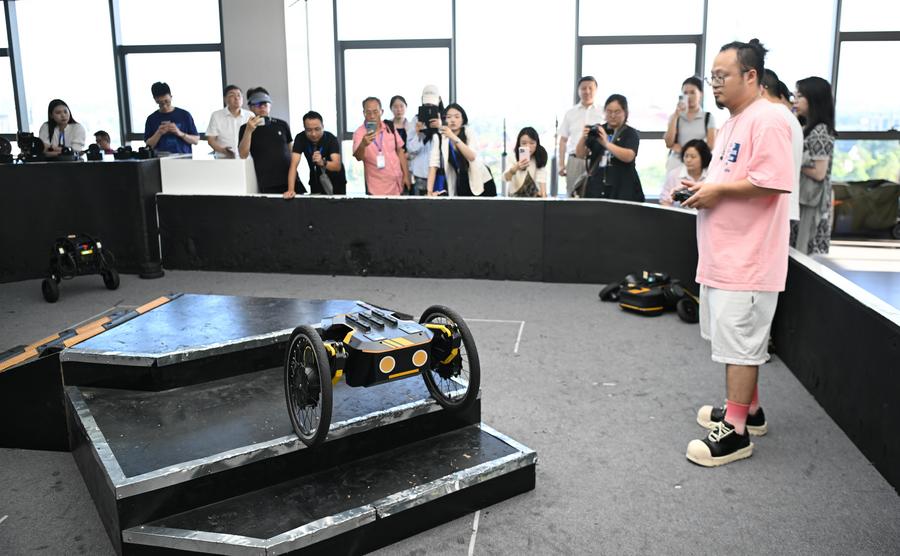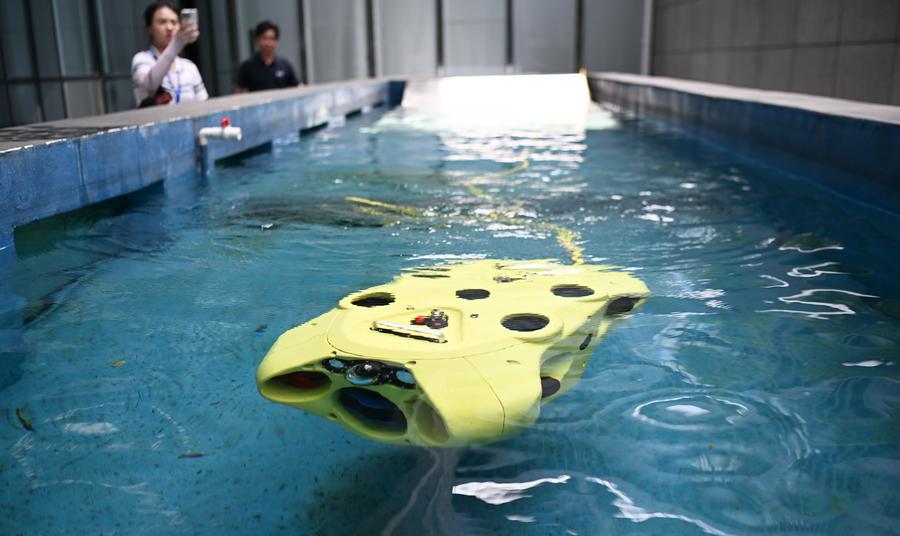
A staff member operates robot to climb stairs at a robot base in Dongguan, south China's Guangdong Province, June 23, 2025. (Xinhua/Deng Hua)
GUANGZHOU, July 13 (Xinhua) -- Songshan Lake, nestled in south China's Guangdong Province, buzzes with youthful energy as tomorrow's tech leaders weave through roads once scented by lychees.
Just two decades ago, this thriving innovation hub was a quiet orchard. Today, it blossoms with ideas instead of fruit.
Covering 103 square kilometers, this high-tech zone hosts over 17,000 market entities. Among them are seven national-level manufacturing champion enterprises and 770 national high-tech enterprises, each playing a part in the rise of new-generation industries technology -- from connected vehicles and robotics to intelligent equipment manufacturing, biomedicine and the frontiers of new materials and energy.
Fueling this rapid enterprise growth is Songshan Lake's innovation ecosystem. It houses six universities and 18 provincial-level new R&D institutions. It is also home to several key scientific facilities, including China Spallation Neutron Source and the under-construction Advanced Attosecond Laser Infrastructure.
The journey of ePropulsion, a company co-founded by Hong Kong University of Science and Technology (HKUST) graduate Pan Zongliang and his three classmates, exemplifies this ecosystem.
In 2012, spotting significant potential in marine new energy, they formed a startup team dedicated to marine electric propulsion R&D. By 2014, they had developed a prototype for their first electric outboard motor. However, turning that breakthrough into a market-ready product was not easy sailing -- industrialization turned out to be a formidable voyage.
Luckily, HKUST professor Li Zexiang founded the XbotPark robotics base within Songshan Lake also in 2014, and Li recommended and helped ePropulsion's five-member team relocate their company to Songshan Lake.
"As a marine new energy company, we needed a water area for product testing," explained Pan, ePropulsion's co-founder and COO. The Songshan Lake administrative committee provided the team a crucial asset: a dedicated water testing dock. "It was tremendous support," Pan recalled.
Beyond policy backing, Songshan Lake's strategic location allows XbotPark companies to leverage the Guangdong-Hong Kong-Macao Greater Bay Area's supply chain advantages.
"Teams here often say, 'If you can imagine it, you can build it'," said director of the XbotPark robotics base. "Good ideas can typically find suppliers for implementation within half an hour."
Today, ePropulsion operates a manufacturing plant in Dongguan City, where Songshan Lake is located, with its products -- ranging from 500W to 1000kW electric outboards, pod drives, inboard systems, and matching battery and control systems -- sold globally.
"Our main market is Europe and the United States, and our small and medium-sized electric outboards ranked first globally in shipments last year," Pan noted. "Domestic market share is also rising with China's expanding new energy vessel sector."
Their green propulsion systems now power boats in events like the SailGP and America's Cup, as well as scenic waters across China, including Wuhan's East Lake, Hangzhou's West Lake, and Guilin's Li River.
According to XbotPark, it has incubated over 80 robotics and smart hardware startups, of which six are unicorns, boasting an over 80 percent survival rate. Its top companies have a cumulative valuation of 10 billion U.S. dollars.

An intelligent underwater robot is tested at a provincial institute of intelligent robotics in Dongguan, south China's Guangdong Province, June 24, 2025. (Xinhua/Deng Hua)
Nearby at the Guangdong Intelligent Robotics Institute (GIRI), another industrial park at Songshan Lake, a bright yellow robot maneuvers in a testing pool, surfacing and diving with fish-like agility. This intelligent underwater inspection robot, developed by BlueDiveBot, performs comprehensive, blind-spot-free surveys.
"Underwater robots can handle equipment maintenance, debris removal, water quality monitoring, and emergency response, overcoming human limitations and safety risks," explained Hu Gangyi, general manager of BlueDiveBot.
Incubated by the GIRI and founded in 2023, BlueDiveBot has established a collaborative innovation platform integrating industry, academia, research, and application for advanced underwater equipment. It has mastered a series of cutting-edge technologies in unmanned underwater intelligent systems, some being domestic firsts.
"The well-developed industrial chain in Dongguan and surrounding areas accelerates our R&D commercialization," Hu said. "We rapidly achieved production capacity and significant market sales growth."
Since its establishment in August 2015, GIRI has focused its R&D and commercialization efforts on core robotics components like high-power lasers, sensors, and machine vision, alongside core products including industrial robots, high-end intelligent equipment, unmanned autonomous systems, and industrial big data.
GIRI vice president Zhou Xiaoxiao likens prototype technology to "an unripe green apple," which needs refinement to turn into "a mature red apple" that can then serve a whole chain of products, such as apple jam and apple juice.
Further empowering innovation, the Songshan Lake high-tech zone partnered with Huawei Cloud to build a developer village in April 2022. It addresses enterprise digitalization needs through deep integration and collaborative innovation among different developer organizations, fostering digital innovation and industrial upgrading. Currently, 29 companies have settled there.
"The Songshan Lake high-tech zone has deployed frontier basic research," concluded Wang Qianqian, deputy director of the Songshan Lake Science, Technology and Innovation Bureau. "Based on fundamental research results, we are forging a complete innovation chain from pioneering research to commercialization and industrial development."








 User Center
User Center My Training Class
My Training Class Feedback
Feedback












Comments
Something to say?
Login or Sign up for free